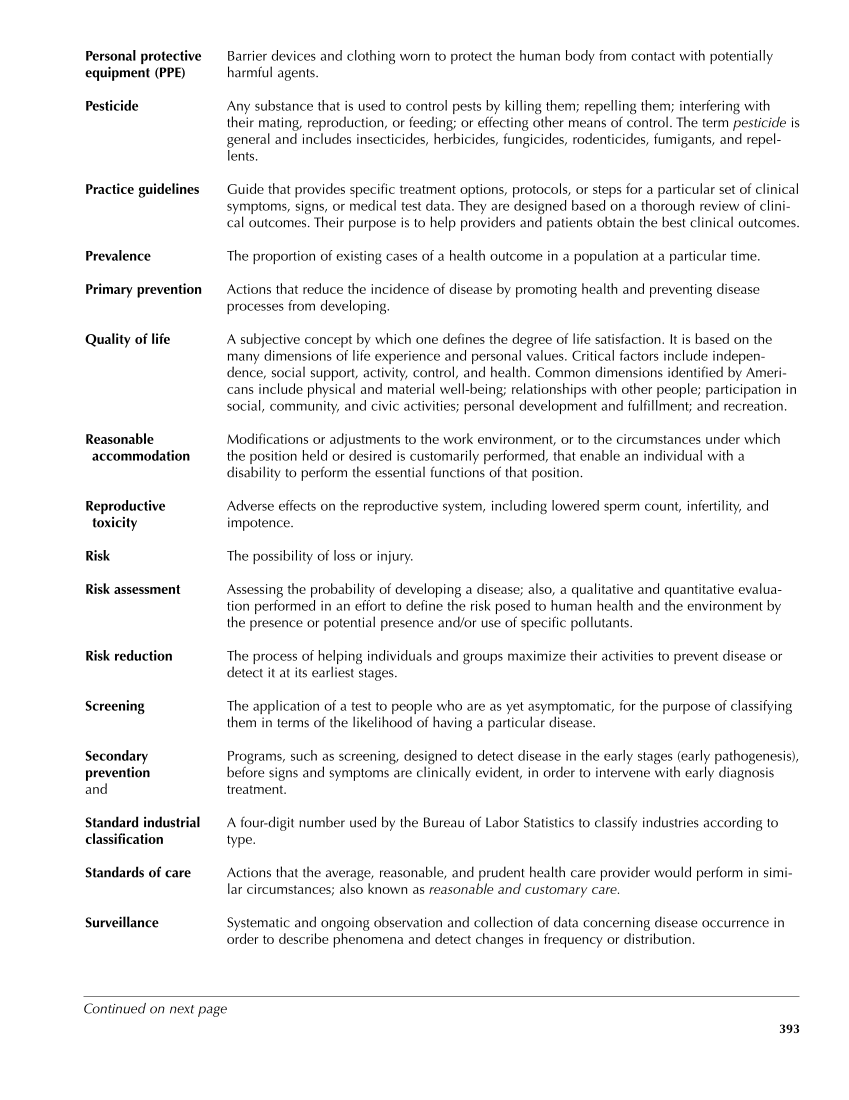393 Personal protective Barrier devices and clothing worn to protect the human body from contact with potentially equipment (PPE) harmful agents. Pesticide Any substance that is used to control pests by killing them repelling them interfering with their mating, reproduction, or feeding or effecting other means of control. The term pesticide is general and includes insecticides, herbicides, fungicides, rodenticides, fumigants, and repel- lents. Practice guidelines Guide that provides specific treatment options, protocols, or steps for a particular set of clinical symptoms, signs, or medical test data. They are designed based on a thorough review of clini- cal outcomes. Their purpose is to help providers and patients obtain the best clinical outcomes. Prevalence The proportion of existing cases of a health outcome in a population at a particular time. Primary prevention Actions that reduce the incidence of disease by promoting health and preventing disease processes from developing. Quality of life A subjective concept by which one defines the degree of life satisfaction. It is based on the many dimensions of life experience and personal values. Critical factors include indepen- dence, social support, activity, control, and health. Common dimensions identified by Ameri- cans include physical and material well-being relationships with other people participation in social, community, and civic activities personal development and fulfillment and recreation. Reasonable Modifications or adjustments to the work environment, or to the circumstances under which accommodation the position held or desired is customarily performed, that enable an individual with a disability to perform the essential functions of that position. Reproductive Adverse effects on the reproductive system, including lowered sperm count, infertility, and toxicity impotence. Risk The possibility of loss or injury. Risk assessment Assessing the probability of developing a disease also, a qualitative and quantitative evalua- tion performed in an effort to define the risk posed to human health and the environment by the presence or potential presence and/or use of specific pollutants. Risk reduction The process of helping individuals and groups maximize their activities to prevent disease or detect it at its earliest stages. Screening The application of a test to people who are as yet asymptomatic, for the purpose of classifying them in terms of the likelihood of having a particular disease. Secondary Programs, such as screening, designed to detect disease in the early stages (early pathogenesis), prevention before signs and symptoms are clinically evident, in order to intervene with early diagnosis and treatment. Standard industrial A four-digit number used by the Bureau of Labor Statistics to classify industries according to classification type. Standards of care Actions that the average, reasonable, and prudent health care provider would perform in simi- lar circumstances also known as reasonable and customary care. Surveillance Systematic and ongoing observation and collection of data concerning disease occurrence in order to describe phenomena and detect changes in frequency or distribution. Continued on next page
Purchased from OEM Press by (ge corporate access). (C) 2013 OEM Health Information, Inc. All rights reserved.












































































































































































































































































































































































































































